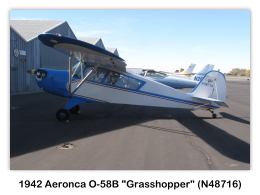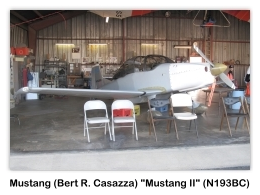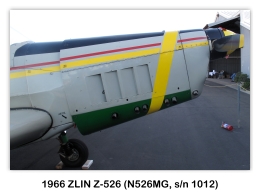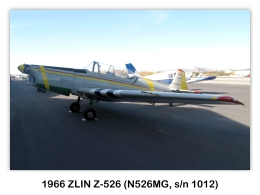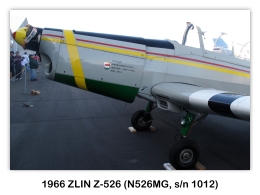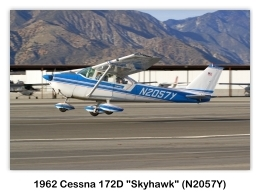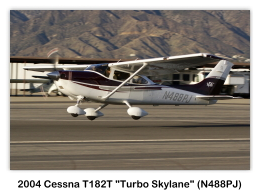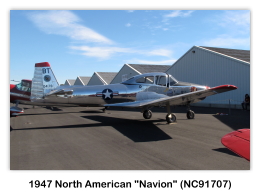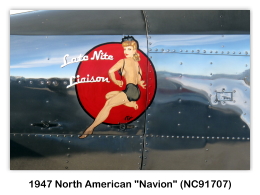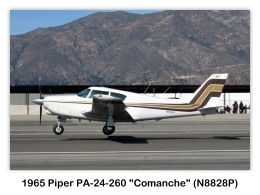

2009 Cable Air Show
11 January 2009 (Sunday Air Show)

Each year, as the big Crystal Ball on top of Times Square drops down to usher in the New Year, we in Southern California start looking forward to the start of the Air Show season. While the East Coast of the United States is still digging out from the snow, the January weather in Southern California is usually in the mid-70s with crisp and clear skies. With the snowcapped peaks of the San Gabriel Mountains serving as a backdrop, the Cable Airport hosts their annual Cable Air Show. The 2009 Cable Air Show marked the 64th anniversary of the Cable Airport and the 34th Annual Cable Air Show. Located in Upland, California, the Cable Airport is the world’s largest family-owned public-use airport. It is located about 40 miles east of Los Angeles.

The 2009 Cable Air Show featured flights of Warbirds, Vintage, Antique and Homebuilt aircraft. Aerobatic performers included: Dr. Frank Donnelly (Dr. D) flying his 1946 Clipped-Wing Taylorcraft known as the ” Tumbling T-Cart” ; Doug Jardine flying his beautiful 1990 Sukhoi Su-26MX; the inaugural performance of Martin Kennedy flying his 1993 Staudacher S-600; and the return of Rob Harrison and his 1976 Zlin Z50LS “Tumbling Bear”. The 2009 Cable Air Show also included the Freedom Parachute Team, the Just In Time Skydivers, and flight demonstrations by the Corona R/C Club. The Air Show was topped off with a drive by of Historical Vehicles and Show Cars.

Air Show Performers
Dr. Frank Donnelly ” Dr. D” and his 1946 Clipped-Wing Taylorcraft … ” Tumbling T-Cart” (N6588C)
Dr. Frank Donnelly and his 1946 ”T-Cart” are based at the Cable Airport in Upland, California. Dr. Frank Donnelly (”Dr. D”) and his 1946 ”T-Cart” bring back old-time aerobatics to be air show circuit. Duane Cole, air show performer of the ’50s and ’60s was his inspiration. Dr. D maneuvers his clipped wing Taylorcraft in graceful loops and rolls in fine Cole fashion. Dr. D. shows the young and the more mature airshow audience what the airshows of the ’50s and ’60s were like as he flies maneuvers within 250 feet of the ground, exercising engine-off airborne maneuvers and the difficult engine-off landing. A proven performer, Dr. Frank Donnelly has flown more than 100 performances at 40 air shows and holds a ground-level waiver. He delivers a slow-motion, captivating aerial display that provides non-stop excitement for everyone. Donnelly started flying aerobatics in a World-War II-era PT-26 Fairchild trainer. Later he graduated to a 1952 British Royal Air Force Chipmunk.




















Doug Jardine and his 1990 Sukhoi Su-26MX (N360MJ)
The aerobatic journey of Doug Jardine began in 1982 when he took a demo ride in the Pitts S-2B. He’s come a long way in 27 years, now piloting an expert only version of the Sukhoi 26 series MX he bought in 2000. Doug completed his first aerobatic competition in 1990 and he hasn’t looked back since winning awards around the United States and Canada.




















WELCOME back! … Rob Harrison and his 1976 Zlin Z50LS (N6660C)
Straight & Level Not Part of His Act! That Rob Harrison would be popping in and out of puffs of white smoke, spinning, diving and twisting through the air in a specially built monoplane, repeatedly contorting his body to resist up to eight times his body weight in pressure, was unthinkable on his first flight. Then, his Dad, a career Naval officer, was at the controls of a Piper Cub, and 6-year-old Rob was scared. Now, nearly six decades later, the Claremont, California. resident, better known in airshow circles as ” The Tumbling Bear,” remembers that first flight. Remembers, sure; dwells upon it, no. There’s the next show, the next new move, the next generation he hopes to pass along his positive attitudes on experimentation and achievement.
The Tumbling Bear, has been a marquee airshow attraction since 1993 when he made the decision to embark on a new career after 28 years with the United States Forest Service. The rarely-seen tumbles and gyrations of his Zlin 50LS are now his trademark in the sky. The maneuvers are best described as gyroscopic, created by the gyroscopic effect of the engine and propeller.
None are more enthralled with his airborne acrobatics than the kids; in turn, their reactions seem to give Harrison the most enjoyment. Harrison added a new feature to his Web site called KidsLink. Wherever the show, he typically is surrounded by youngsters after touching down. He hands out collector cards, pins, washable tattoos and other personalized giveaways. His 12-minute routine is taxing; two a day are exhausting. He repeatedly uses all his strength to brace his body.
Rob earned a B.S. in Mechanical Engineering at Oregon State and a law degree from La Verne (CA) University. He added a certificate in flight test engineering from the University of Tennessee Space Institute and an FAA Statement of Aerobatic Competency, which allows him a waiver for unrestricted aerobatics. He is also an Aerobatic Competency Examiner, or ACE. This puts him in select company. ” There might be 100 active ACES who are allowed to license others to perform in airshows,” Harrison explains.
Harrison traveled to the Czech Republic, graduated from the Zlin Air School’s advanced aerobatics school, and ordered his own edition of the plane. His current aircraft plane is his Zlin 50LS, designed in the Czech Republic to compete in European and World Championship flying competitions.


















Martin Kennedy and his 1993 Staudacher S-600 (N993DD)
The 2009 Cable Air Show was Martin Kennedy’s inaugural performance as an Air Show performer. Martin learned to fly at Cable Airport and Rob Cable sold him his first airplane, so flying his aerobatic routine at the Cable Air Show has a great significance for him. He is flying a 330-hp 1993 Staudacher S-600 (N993DD) with an impressive smoke system. The Staudacher S-600 is loud and generates spectacular tumbles, torque rolls and is famous for its snaps. Martin flies one of the most athletic 10g routines you will find, made possible by the design and strength of his Staudacher S-600 aerobatic aircraft. Martin performed gyroscopics and outside maneuvers. He opened his routine with eight continuous snap rolls into a -7g spiral tower, which appeared to send the Staudacher S-600 flying backwards in the horizontal plane at the top of the figure. To learn more about Martin Kennedy and his Staudacher S-600.
Since this was Martin’s inaugural performance, his fellow aerobatic performers Doug Jardine (Sukhoi 26) and Rob Harrison (Tumbling Bear) had a surprise for him when he finished his inaugural performance.
Martin Kennedy and his 1993 Staudacher S-600 (N993DD, s/n 15)















After returning from his inaugural Air Show performance, Martin Kennedy received an aquatic gift from Rob Harrison (” The Tumbling Bear.” )







Freedom Parachute Team
The Freedom Parachute Team has wowed spectators across the nation for more than 25 years. Colorful smoke trails across the sky and a huge American Flag are gently brought to the taxiway in this spectacular salute to our freedom and the freedom of flight.

























Corona R/C Club
The Corona RC Club is a family oriented club that has a strong focus on enjoying the sport of radio control modeling. They are always searching for more people to enjoy their passion with. They invite anyone to come on out and join them. The Corona R/C club was established in 1981. The club is represented at many local air shows every year. The club is very fortunate in that they have an excellent flying field, La Sierra/Arlington Field, that they can fly at 7 days a week. The Corona R/C club has evolved from the early days of ” radio guided free flight,” to today’s 40% and 50% scale models with full controls, which cost up to $10,000. Unlike earlier models of balsa and tissue or doped silk, many these new airframes are made of composites. At each air show, a drawing each day to select winner who gets instruction from club members on how to fly a R/C plane!



















































Just In Time Skydivers
Just In Time Skydivers started in 1967 on the East Coast. Based out of Lakewood, New Jersey, the team jumped the then-current low-performance round parachutes into air shows and other special events. Moving to the West Coast in 1970 they now operate out of Lake Elsinore, California and jump state-of-the-art equipment and high-performance ram-air parachutes. Through the years they have jumped into places like Dodger Stadium, Santa Anita Racetrack, the Queen Mary, the Rose Bowl, and the bottom of the Grand Canyon! During the 2009 Cable Air Show, three skydivers from the team exited their Cessna 182, piloted by Dean Moya, at 5,500 feet (over a mile high) and began their 120 mph free full during a three-way formation as they dropped 3,500 feet. At an altitude of 2,000 feet, they open their chutes and began a two minute sail to the ground.


2009 Cable Air Show — Static Displays
Aero Commander 100
The Aero Commander 100, various models of which were known as the Darter Commander and Lark Commander was a US light aircraft produced in the 1960s. It was a high-wing monoplane of conventional design, equipped with fixed tricycle undercarriage.
1968 Aero Commander 100 (N269DA, s/n 269)
1969 Aero Commander 100 (N4159X, s/n 341)

Aeronca O-58B “Grasshopper”
The Aeronca L-3 / O-58 group of observation and liaison aircraft were used by the United States Army Air Corps in World War II. The L-3 series were adapted from Aeronca’s pre-war Tandem Trainer and Chief models. The L-3 was initially designated the O-58 at the time it was first ordered by the Air Corps. The airplane was given its service tests in the summer of 1941 during maneuvers in Louisiana and Texas where it was used for various support purposes such as a light transport and courier.
1942 Aeronca O-58B “Grasshopper” (N48716, s/n 058B-6452)
Beech Bonanza B36TC “Turbine Air”
The Beechcraft Bonanza is an American general aviation aircraft introduced in 1947 by The Beech Aircraft Corporation of Wichita, Kansas. As of 2009 it is still being produced by Hawker Beechcraft and has been in continuous production longer than any other airplane in history. More than 17,000 Bonanzas of all variants have been built.
199 Beech “Bonanza” B36TC “Turbine Air” (N307M, s/n EA-650)
1941 Boeing-Stearman B75N1
The Stearman (Boeing) Model 75 is a biplane, of which at least 9,783 were built in the United States during the 1930s and 1940s as a military trainer aircraft. Stearman became a subsidiary of Boeing in 1934. Widely known as the Stearman, Boeing Stearman or Kaydet, it served as a Primary trainer for the USAAF, as a basic trainer for the USN (as the NS & N2S), and with the RCAF as the Kaydet throughout World War II. After the conflict was over, thousands of surplus aircraft were sold on the civil market. In the immediate post-war years they became popular as crop dusters and as sports planes.
1941 Boeing-Stearman B75N1 (NC68800, s/n 75-1694)
2007 Mustang Aeronautics “Mustang II”
The Mustang Aeronautics “Mustang II” is a high performance side-by-side seating aircraft designed for both sport and cross country flying. It is unmatched in speed for the dollar and ease of construction. It features a tapered wing, helping to make it a solid cross country airplane capable of high and long IFR flights.
2007 Casazza “Mustang II” (Burt R. Cassazza) (N193BC, s/n M-II 193)
1978 Cessna 152
During 1977 Cessna introduced a new two-seat cabin monoplane to replace the Model 150, which had been in production for almost 20 years. Designated Model 152, it differs primarily in having a more powerful engine, using low-lead 100 octane fuel, an improved ’gull wing’ propeller, and power plant installation and cowling changes to reduce engine noise and vibration.
1978 Cessna 152 (N67282, s/n 15281722)
1950 Cessna 170A
The Cessna 170 is a light, single-engine, general aviation aircraft produced by the Cessna Aircraft Company between 1948 and 1956. In late 1948 Cessna began sales of the 170, with metal fuselage and tail and fabric covered wings. These earliest 170s were four-seat versions of the popular 140 with a more powerful 145 hp (108 kW) Continental O-300 and larger fuel tanks. Like the 140, they were constructed of metal with fabric-covered wings supported by a “V” strut.
1950 Cessna 170A (N170RS, s/n 19611)
1977 Cessna 177B “Cardinal”
The Cessna 177 Cardinal is a light, high-wing general aviation aircraft that was intended to replace Cessna’s 172 Skyhawk. First announced in 1967, it was produced from 1968 to 1978. The Cessna 177 was designed in the mid-1960s when the engineers at Cessna were asked to create a “futuristic 1970s successor to the Cessna 172” . The resulting aircraft featured newer technology such as a cantilever wing with a laminar flow airfoil. The Cessna 177 is the only production high-wing single-engine Cessna since the Cessna 190/195 series to have both fixed landing gear and a cantilever wing without strut bracing.
1977 Cessna 177B Cardinal (N20124, s/n 17702631)
1943 Douglas C-53D-DO “Skytrooper” (D-Day Doll)
The Douglas aircraft Company at Santa Monica, California developed the C-53 “Skytrooper” from its famous DC-3 airliner at the request of the Army Air Corps to fill the need for a paratroop carrier. A total of 403 C-53s were built of all versions. The C-53D-DO “Skytrooper” shown below s/n AF 42-68830, was one of 159 “D” models and came off the assembly line on July 6, 1943. This aircraft is stationed at the Riverside municipal Airport, and operated by the Commemorative Air Force Inland Empire Wing.
1943 Douglas C-53D-DO “Skytrooper—D-Day Doll” (N45366, AF 42-68830, c/n 11757)
1986 Fokker S-11-1 “Instructor”
The Fokker S-11 “Instructor” is a single engine two seater propeller aircraft designed and manufactured by the former Dutch aircraft manufacturer Fokker.
1986 Fokker S-11-1 “Instructor” (N911J, s/n E-11)
1946 Globe GC-1B “Swift”
The Globe Swift (also known as the Globe/Temco Swift), first advertised as the “All Metal Swift”, was a light, two-seat sport monoplane of the post-World War II period. Designed by R.S. “Pop” Johnson in 1940, the fanciful story of a Culver Cadet obtained as a “template” aircraft has now entered into popular mythology surrounding the aircraft’s origins. The design was secured by John Kennedy, president of the Globe Medicine Company, to be built by his new Globe Aircraft Company. World War II interrupted their plans, however, and the 85 hp GC-1A Swift advertised as the “All Metal Swift” re-designed by K.H. “Bud” Knox, received its type certificate on 7 May 1946. Two prototypes were built but essentially, the design remained the same as the type entered production. Globe built about 408 GC-1As.
1946 Globe GC-1B “Swift” (N3214K, s/n 1207)
1934 Kinner “Sportster K”
The Kinner Sportster was a 1930s American light monoplane built by Kinner Airplane & Motor Corporation.
1934 Kinner “Sportster K” (NC14218, s/n 136)
North American P-51D “Mustang”
The North American Aviation P-51 Mustang was a long-range single-seat World War II fighter aircraft. Designed, built and airborne in just 117 days, the Mustang first flew in RAF service as a fighter-bomber and reconnaissance aircraft before conversion to a bomber escort, employed in raids over Germany, helping ensure Allied air superiority from early 1944. The P-51 was in service with Allied air forces in Europe and also saw limited service against the Japanese in the Pacific War. The Mustang began the Korean War as the United Nations’ main fighter, but was relegated to a ground attack role when superseded by jet fighters early in the conflict. Nevertheless, it remained in service with some air forces until the early 1980s.
North American P-51D-25-NT “Mustang — Su Su” (N514NH, AF 44-84850)
Piper J3C-65 “Cub”
The Piper J-3 Cub is a small, simple, light aircraft that was built between 1937 and 1947 by Piper Aircraft. With tandem (fore and aft) seating, it was intended for flight training but became one of the most popular and best-known light aircraft of all time. The Cub’s simplicity, affordability and popularity invokes comparisons to the Ford Model T automobile. The Cub’s standard yellow paint has come to be known as “Cub Yellow.”
1946 Piper J3C-65 “Cub — Li’L Panda” (N92497, s/n 16921)
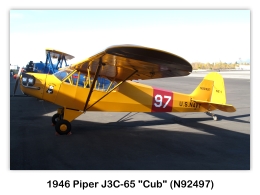
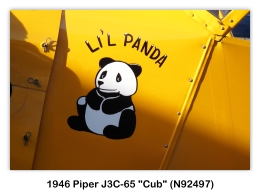
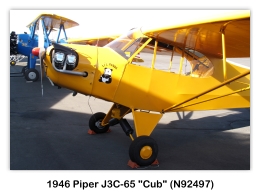
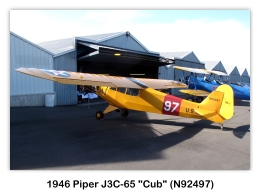
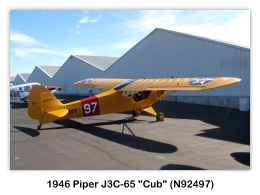
Piper PA-28-140 “Cherokee 140”
The Piper PA-28-140 Cherokee is a member of a family of light aircraft designed for flight training, air taxi and personal use, built by Piper Aircraft. All members of the PA-28 family are all-metal, unpressurized, four-seat, single-engine piston-powered airplanes with low-mounted wings and tricycle landing gear. All PA-28 aircraft have a single door on the co-pilot side, which is entered by stepping on the wing. The first PA-28 received its type certificate from the FAA in 1960 and the series remains in production in 2009. Current models are the Arrow and Warrior III. The Archer was discontinued in 2009, but will be revived in 2010.
1968 Piper PA-28-140 “Cherokee 140” (N6794J, s/n 28-24533)
Piper “Aerostar 601P”
The Piper Aerostar or Ted Smith Aerostar is an American twin-engine propeller-driven executive or light transport aircraft, designed by Ted R. Smith. It was originally built by Ted Smith Aircraft Company, which after 1978 became part of the Piper Aircraft Corporation.
1977 Piper “Aerostar 601P” (N11TT, s/n 61P-0394-134)
Porterfield CP-65 “Collegiate”
The Porterfield Collegiate was an American two-seat training monoplane built by the Porterfield Aircraft Corporation of Kansas City. Developed originally as the Porterfield “Zephyr” a light-weight version of the earlier Model 35 “Flyabout” for use a pilot trainer. Powered by a 40-hp (30kW) Continental A-40 engine it was later re-designated the Porterfield CP-40. To improve performance the engine was replaced with a 50-hp (47kW) Continental A50-4 engine and re-designated the CP-50 Collegiate. It was a braced high-wing monoplane with a tailskid fixed landing gear. Total production was about 400 when production stopped in 1941 at the start of American involvement in the Second World War. A number of variants were produced with different engine installations.
1941 Porterfield CP-65 “Collegiate” (NC37895, s/n 1025)
Stinson L-5B “Sentinel”
The Stinson L-5 “Sentinel” began life as the pre-war Stinson model 105. The model 105 was nicknamed “Voyager” and was built by the Stinson division of Consolidated Vultee. When World War II broke out, the Voyager was redesigned and then entered into service as a liaison aircraft. It also flew in the artillery spotter role and as an air ambulance. The later model Stinson L-5 Sentinels had their fuselages modified to accommodate one stretcher patient. The Stinson L-5 Sentinels were manufactured between October 1942 and September 1945. During this time a total of over 3,896 of these unarmed, two-seat aircraft were built for the United States armed forces, making it the second most widely used light observation aircraft of the war. Personnel in all service branches commonly referred to it as the “Flying Jeep”.
1944 Stinson L-5B “Sentinel — Porchdog” (N5607V, s/n 2946)
Taylorcraft BL-65
The Taylorcraft B is a light, side-by-side two place, single engine, high wing general aviation monoplane that was built by the Taylorcraft Aviation Corporation of Alliance, Ohio. The aircraft was available as a land plane and a floatplane.
1939 Taylorcraft BL-65 (N23844, s/n 1480)
Waco UPF-7
The Waco F series was a range of American-built private pilot owner and training biplanes of the 1930s from the Waco Aircraft Company.
1940 Waco UPF-7 “Lil Passion” (NC29338, s/n 5365)
ZLIN Z-526
The Zlin Z-526 is a Czech built aircraft that was originally designed by Zlin Aircraft in 1959. Its two seat version is called the Trener-Master. The Zlin Z-526’s layout was organized with pilot in the rear, and student in front. The aircraft could also be equipped with tip tanks and a constant speed propeller.
1966 ZLIN Z-526 (N526MG, s/n 1012)
2009 Cable Air Show — Parade of Historic Vehicles and Show Cars
2009 Cable Air Show — Flights of Vintage, Antique and Homebuilt Aircraft
American Champion 8KCAB “Super Decathlon”
The 8KCAB Decathlon and Super Decathlon are two-seat fixed conventional gear light airplanes designed for flight training and personal use and capable of sustaining aerobatic stresses between +6g and -5g. The Decathlon entered production in the United States in 1970 as a more powerful and stronger complement to the Citabria line of aircraft.
American Champion 8KCAB “Super Decathlon” (N81SD, s/n 922-2003)
Beech F33A “Bonanza”
The Beechcraft Bonanza is an American general aviation aircraft introduced in 1947 by The Beech Aircraft Corporation of Wichita, Kansas. As of 2009 it is still being produced by Hawker Beechcraft and has been in continuous production longer than any other airplane in history. More than 17,000 Bonanzas of all variants have been built.
1979 Beech F33A “Bonanza” (N913KM, s/n CE-892)
Boeing-Stearman PT-17 “Kaydet”
The Stearman (Boeing) Model 75 is a biplane, of which at least 9,783 were built in the United States during the 1930s and 1940s as a military trainer aircraft. Stearman became a subsidiary of Boeing in 1934. Widely known as the Stearman, Boeing Stearman or Kaydet, it served as a Primary trainer for the USAAF, as a basic trainer for the USN (as the NS & N2S), and with the RCAF as the Kaydet throughout World War II. After the conflict was over, thousands of surplus aircraft were sold on the civil market. In the immediate post-war years they became popular as crop dusters and as sports planes.
Boeing-Stearman PT-17 “Kaydet” (N4432Q, s/n 75-1969)
1946 Cessna 140
The Cessna 120 and the Cessna 140 are single engine, two-seat, light general aviation aircraft that were first produced in 1946, immediately following the end of World War II. Production ended in 1950, and was succeeded by the Cessna 150, a similar two-seat trainer which introduced a tricycle gear. The 120 and the 140, together, sold 7,664 copies in the five years that the aircraft were produced.
1946 Cessna 140 (N76496, s/n 10926)
Cessna 172 “Skyhawk”
The Cessna 172 “Skyhawk” is a four-seat, single-engine, high-wing fixed-wing aircraft. It was first flown in 1955 and still in production, more Cessna 172s have been built than any other aircraft.
1962 Cessna 172D Skyhawk (N2057Y, s/n 17249557)
1971 Cessna 172L Skyhawk (N3886Q, s/n 17259986)
1976 Cessna 172M Skyhawk (N1352U, s/n 17267023)
1959 Cessna 175 “Skylark”
The Cessna 175 Skylark is a four-seat, single-engine, high-wing airplane produced between 1958 and 1962. The Cessna 175 was designed to fill a niche between the Cessna 172 and the heavy-duty Cessna 180. The engine of the Cessna 175 was rated at 175 hp (130 kW), or 30 hp (22 kW) more than the engine of the Cessna 172. Between 1958 and 1962, a total of 2,106 were built. The basic airplane was marketed as the Cessna 175, and the plane with a package of optional equipment and a special paint scheme was marketed as the Cessna 175 “Skylark.”
1959 Cessna 175 Skylark (N7688M, s/n 55988)
Cessna 182 “Skylane”
The Cessna 182, marketed under the name “Skylane” , is a four-seat, single-engine, light airplane. It has the option of adding two child seats, installed in the baggage area. Introduced in 1956, the Cessna 182 has been produced in a number of variants, including a version with retractable landing gear, and is the second most popular Cessna model, after the Cessna 172 “Skyhawk”.
1964 Cessna 182G Skylane (N2040R, s/n 18255240)
1975 Cessna 182P Skylane (N9910E, s/n 18263970)
1972 Cessna 182P Skylane (N21238, s/n 18261508)
2004 Cessna T182T Turbo Skylane (N488PJ, s/n T18208333)
1949 Cessna 195
The Cessna 190 and 195 Businessliner are a family of light single radial engine powered, conventional landing gear equipped, general aviation aircraft which were manufactured by Cessna between 1947 and 1954. The 195 model was also used by the United States Air Force, Air National Guard and Army as a light transport and utility aircraft under the designation LC-126A.
1949 Cessna 195 (N195SC, s/n 7402)
1959 Commonwealth CA-25 “Winjeel”
The CAC CA-25 “Winjeel” (aboriginal for young eagle) entered service with the Royal Australian Air Force in 1955 as an ab-initio to advanced trainer aircraft.
1959 Commonwealth CA-25 “Winjeel” (NX107PJ, s/n A85-429)
1968 De Havilland Canada DHC-6 “Twin Otter”
The DHC-6 Twin Otter is a 20-passenger STOL (Short Takeoff and Landing) utility aircraft developed by de Havilland Canada. The aircraft’s fixed tricycle undercarriage, STOL abilities and high rate of climb have made it a successful cargo, regional passenger airliner and MEDEVAC aircraft. In addition, the Twin Otter has been popular with commercial skydiving operations.
1968 De Havilland Canada DHC-6 “Twin Otter” (N64150, s/n 150)
1940 De Havilland DH.82A “Tiger Moth”
The de Havilland DH.82 “Tiger Moth” is a 1930s biplane designed by Geoffrey de Havilland and was operated by the Royal Air Force and others as a primary trainer. The Tiger Moth remained in service with the RAF until 1952 when many of the surplus aircraft entered civil operation. Many other nations used the Tiger Moth both in military and civil applications and the ubiquitous little trainer is still in great demand worldwide as a recreational aircraft. It is still occasionally used as a primary training aircraft, although now most Tiger Moths employed in training duties are used by pilots gaining experience for “taildragger” license ratings.
1940 De Havilland DH.82A Tiger Moth (N523R, s/n 82960)
1946 Erco “Ercoupe 415-C”
The ERCO Ercoupe is a low wing monoplane first manufactured by the Engineering and Research Corporation (or ERCO) shortly before World War II. It was designed to be the safest fixed-wing aircraft that aerospace engineering could provide at the time, and the type still enjoys a very faithful following today. In late 1931, aeronautical engineer Fred Weick was the assistant chief of the aeronautics division of the National Advisory Committee for Aeronautics (NACA). A group of co-workers and he designed and assembled an experimental aircraft in 1934 with a group of his colleagues. Responding to a Bureau of Air Commerce sponsored design competition to build an easy-to-fly, safe aircraft, Weick and his friends worked on the project in their spare time and paid for it themselves.
1946 Ercoupe 415-C (N3437H, s/n 4062)
2002 Lancair IV-P
The Lancair IV and Lancair IV-P are a family of four-seat low-wing retractable-gear composite monoplanes powered by a 550 cubic inch Continental turbo-normalized piston engine.
2002 Lancair IV-P (N111HH, s/n HHF001)
North American SNJ-5 “Texan”
The North American SNJ “Texan” was a single-engine advanced trainer aircraft used to train fighter pilots of the United States Navy and United States Marine Corps during World War II. The North American AT-6 “Texan” / SNJ “Texan” / “Harvard” was first produced in 1939 and was similar to and eventually replaced the North American BC-1A basic combat trainer when the Basic Combat classification was abandoned. The USAAC designated it as the “AT-6” , the US Navy the “SNJ” , and British Commonwealth air forces, the “Harvard” , the name it is best known by outside of the United States. The North American AT-6 “Texan” is known by a variety of designations depending on the model and operating air force.
North American SNJ-5 “Texan” (N7300C, BuNo 43763)
North American “Harvard IIA”
The North American “Harvard” was a single-engine advanced trainer aircraft used to train fighter pilots of the Royal Air Force and other air forces of the British Commonwealth during World War II. The North American AT-6 “Texan” / SNJ “Texan” / “Harvard” was first produced in 1939 and was similar to and eventually replaced the North American BC-1A basic combat trainer when the Basic Combat classification was abandoned. The USAAC designated it as the “AT-6” , the US Navy the “SNJ” , and British Commonwealth air forces, the “Harvard” , the name it is best known by outside of the United States. The North American AT-6 “Texan” is known by a variety of designations depending on the model and operating air force.
North American “Harvard IIA” (N96281, s/n 3832)
North American “Navion”
The Navion is a United States single-engine, four-seat aircraft originally designed and built by North American Aviation in the 1940s. It was later built by Ryan Aeronautical Company and the Tubular Steel Corporation (TUSCO).
North American “Navion” “Late Nite Liaison” (NC91707, s/n NAV-4-178)
North American “Navion” (N91103, s/n NAV-4-5)
North American B-25J-10-NC (TB-25N) “Mitchell - Pacific Princess” (N9856C, AF 43-28204)
The North American B-25 Mitchell was an American twin-engine medium bomber manufactured by North American Aviation. It was used by many Allied air forces, in every theater of World War II, as well as many other air forces after the war ended, and saw service across four decades. The North American B-25 was named in honor of General Billy Mitchell, a pioneer of U.S. military aviation. The North American B-25 is the only American military aircraft named after a specific person. By the end of its production, nearly 10,000 B-25s in numerous models had been built. These included a few limited variations, such as the US Navy’s and US Marine Corps’ North American PBJ-1 patrol bomber and the Army Air Forces’ North American F-10 photo reconnaissance aircraft.
North American B-25J-10-NC (TB-25N) "Mitchell — Pacific Princess" (N9856C, AF 43-28204)
North American “Texan / Harvard / Mitchell” Formations
Always a crowd pleaser at Air Shows are the “Heritage Flights” . In this case a North American Texan, Harvard, and Mitchell formation made several passes. The flight was in reality a “North American Family Heritage” event.
North American SNJ-5 “Texan” / “Harvard IIA” / TB-25N “Mitchell” Formations
Piper PA-24-260 “Comanche”
The Piper PA-24 “Comanche” is a four-seat, low-wing, all-metal, light aircraft of monocoque construction with retractable landing gear, The prototype Comanche first flew on 24 May 1956.
1965 Piper PA-24-260 “Comanche” (N8828P, s/n 24-4284)
Piper PA-28-180 “Cherokee 180”
First flown on January 14, 1960, the Cherokee is a low-cost four-seat all-metal low-wing monoplane with a non-retractable tricycle landing gear. Only 1,200 parts go into its “manufacture” , compared with over 1,600 in the four-seat high-wing Piper Tri-Pacer, which preceded it. The first production Cherokee flew on February 10, 1961 and production reached four aircraft per day by the beginning of 1962. The 1,000th Cherokee was delivered on January 24, 1963.
1966 Piper PA-28-180 “Cherokee 180” (N9085J, s/n 28-3122)

Piper PA-28-181 “Archer II”
First flown on January 14, 1960, the Cherokee is a low-cost four-seat all-metal low-wing monoplane with a non-retractable tricycle landing gear. Only 1,200 parts go into its “manufacture” , compared with over 1,600 in the four-seat high-wing Piper Tri-Pacer, which preceded it. The first production Cherokee flew on February 10, 1961 and production reached four aircraft per day by the beginning of 1962. The 1,000th Cherokee was delivered on January 24, 1963.
1975 Piper PA-28-181 “Archer II” (N4410X, s/n 28-7690012)
1976 Piper PA-28-181 “Archer II” (N8788E, s/n 28-7690204)
Piper PA-28R-200 “Cherokee Arrow”
In 1967, Piper introduced the PA-28R-180 Arrow. This aircraft featured a constant-speed propeller and retractable landing gear and was powered by a 180-hp (134 kW) Lycoming IO-360-B1E engine. A 200-hp (149 kW) version powered by a Lycoming IO-360-C1C was offered as an option beginning in 1969 and designated the PA-28R-200.
1975 Piper PA-28R-200 “Arrow” (N32978, s/n 28R-7535103)
Rutan “Vari-Eze”
The Rutan VariEze is a composite, canard aircraft designed by Burt Rutan. It is a fairly high-performance homebuilt, hundreds of which have been constructed. The design later evolved into the Long-EZ and other, larger cabin canard aircraft. The Varieze is notable for popularizing the canard configuration and moldless composite construction for homebuilt aircraft.
1990 Rutan “Vari-Eze” (N88ED, s/n 946)
Ryan Aeronautical PT-22 “Recruit” (Model ST3KR)
The Ryan PT-22 Recruit is a military trainer aircraft that was used by the United States Army Air Corps and it successor, the United States Army Air Forces for primary pilot training. It was the first monoplane that the Army had used for primary pilot training, as all previous PT aircraft were biplanes.
1941 Ryan Aeronautical PT-22 “Recruit” (N48742, s/n 1298)
1976 SIAI-Marchetti SF-260M
The Aermacchi SF.260 is a light aircraft marketed as an aerobatics plane and a military trainer. It was designed by Stelio Frati, originally for Aviamilano, which flew the first prototype of it (then designated F.260) on July 15, 1964. Actual production was undertaken when SIAI Marchetti purchased the design soon thereafter and continued with this firm until the company was bought by Aermacchi in 1997. The military versions are popular with smaller air forces, which can also arm it for use in the close-support role. The design is a conventional one, featuring a low wing and tricycle undercarriage, and is often praised for its sleek lines and sporty appearance. The pilot and up to two passengers (or pilot and one student in trainer versions) are accommodated under a broad, extensively glazed canopy.
1976 SIAI-Marchetti SF-260M (N26AE, s/n 230(2106))
Stoddard-Hamilton “Glasair I”
The Glasair I, originally built as the prototype Glasair TD taildragger, is a high-performance homebuilt aircraft built of fiberglass. Created by Tom Hamilton as a fast, two-seat kitplane, the Glasair TD first flew in 1979. Hamilton formed Stoddard-Hamilton Aircraft that year to produce and market the kit, which was the first pre-molded composite aircraft available to builders.
1997 Stoddard-Hamilton (Jerry A. Hollandsworth) Glasair I GL20 (N115GL, s/n 115)
Vans RV-6
The Van’s RV-6 is a two-seat, single-engine, low-wing homebuilt airplanes sold in kit form by Van’s Aircraft. The RV-6 is the tail-wheel equipped version. The RV-6 was the first aircraft in the popular Van’s RV series to feature side-by-side seating and the first to offer a nosewheel option. It was first flown in 1985. Over 2000 kits have been completed and flown.
1997 Gary Sobek Vans RV-6 (N157GS, s/n 20480)
Vans RV-6A
The Van’s RV-6A is a two-seat, single-engine, low-wing homebuilt airplanes sold in kit form by Van’s Aircraft. The RV-6A features a nose-wheel. The RV-6 was the first aircraft in the popular Van’s RV series to feature side-by-side seating and the first to offer a nosewheel option. It was first flown in 1985. Over 2000 kits have been completed and flown.
2000 Paul Rosales Vans RV-6A (N628PV, s/n 24279)
Vans RV-6 and RV-6A Formation Flight
The Van’s RV-6 and RV-6A are two-seat, single-engine, low-wing homebuilt airplanes sold in kit form by Van’s Aircraft. The RV-6 is the tail-wheel equipped version while the RV-6A features a nose-wheel. The RV-6 was the first aircraft in the popular Van’s RV series to feature side-by-side seating and the first to offer a nosewheel option. It was first flown in 1985. Over 2000 kits have been completed and flown.
Vans RV-6 (N157GS) and RV-6A (N628PV) Formation Flight
Copyright © 1998-2020 (Our 22nd Year) Skytamer Images, Whittier, California
ALL RIGHTS RESERVED




























































